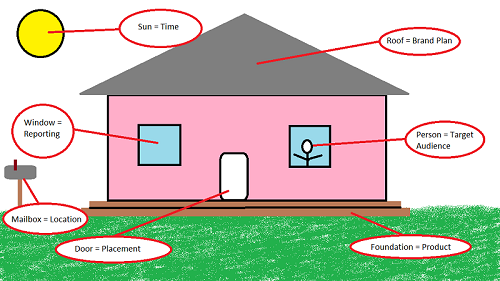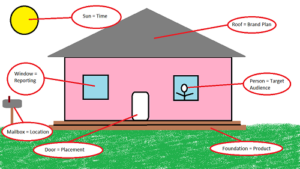Digital Media Targeting for Beginners
Targeting Causes Bullseyes or Black Eyes
Digital display media is a popular channel for marketing brands. We often equate the term to website banner ads, but it also includes video ads, social media ads, audio ads via music sites and apps, in-app ads, search engine marketing and more. It seems like there is always something new under the digital media moniker. Most often, though, discussions center around best practices for banner design, messaging or placements. These are important factors in a successful media campaign, but digital media targeting can make or break a campaign. It’s crucial in ways many people do not realize, plus it affects every form of digital media marketing.
Targeting breaks down easily into three components: who, when and where. We’ll cover the where another time when we discuss how to select placements. Because so many advertising platforms focus on when and who, we’re going to these these today.
Frequently Used DIY Digital Media Systems
Let’s be honest: A lot of digital media distribution networks–especially programmatic ones–are pretty expensive. Many will start at $10,000 per month. It’s advisable for 15-20% of your overall operational budget to go to marketing, so if your overall operations costs less than $800,000 per year or if you want to work in more than one channel (which you really should consider), this is probably not the best option. If this amount is a realistic expenditure, though, it’s programmatic platforms are a great choice, allowing you to target people based on a variety of parameters across multiple websites.
When dipping your toe into digital media for the first time, you’ll likely turn to Facebook ads or Google Display Network (this post has these two systems specifically in mind). These both have their strengths and weaknesses. More importantly, they operate on a cost-per-click basis, making them affordable options. The systems are responsive in real time, and you can set daily and overall budgets so that you don’t blow past your budget. Digital media targeting is paramount within Facebook ads and GDN. Targeted incorrectly, you either deal with a flood of unqualified website traffic or a trickle of traffic that may be exceptionally expensive.
It’s probably easiest to think of a digital media campaign as a house.
Build the House
At the top of this article is my exceptionally poor drawing of a house. Here it is again. It’s labeled, and you can feel free to print it out and mock it. The info is sound, and if anyone wants to make this pretty, I am all for it. I will even replace the cruddy drawing on this post.
Fundamental Needs for a Digital Display Campaign
There are two major prerequisites for digital display media campaigns, and they make a huge difference in how you plan everything.
Brand Plan
Like a roof, everything falls under a brand plan. It guides who your ideal customer is as well as what messaging you need to use. Brand plans help you make decisions. Like a roof, more or less everything will falls under a brand plan. Like a roof, they are held up by other parts.
Product
You brand, product or service is the base from which you build. Like you cannot build a house without a foundation, you cannot run digital media ads without something people will be interested in. Products are like foundations in that a good product will prop up everything you build on top of it. A weak product, though? Let’s not talk about that.
Digital Display Targeting Is Everywhere
When targeting, once you determine the channel you want to use (which, again, we’ll talk about in a later post), there are still a lot of decisions to make regarding time, location and details specific to the product.
Time
Represented above by the sun, timing can be crucial when trying to reach your best customers with digital display media. For instance, if you want to reach stay-at-home parents, you might think about not running your ads between 2:00 and 4:00 p.m. That’s when they’re likely to be picking their kids up from school. Alternately, if you want to reach oil and gas executives, you probably want to try and only run ads during business hours.
Location
There are certain people that only exist in certain locations. Need to reach football fans on a Sunday? You may want to target known areas for tailgating as well as sports bars.
Target Audience
- Affinity groups: Available via Google Display Network, affinity groups are loosely defined as people who have expressed an interest in brands similar to yours. In execution, though, the groups are painted with broad strokes, such as “TV Lovers.” With some refining, this is a highly effective starting point.
- Interests: Interests are a bit different from Google to Facebook. Google uses information from user accounts (search and in some cases Gmail) to determine what a person is likely to be interested in. Facebook uses things people have actually liked within the social network. Self-declared info, in my opinion, is always better.
- Demographics: Demographic data includes gender, age and parental status. Nine times out of ten, this is the easiest information to gather since you can find it within your brand’s analytics data.
- Languages: Like demographics, this is another no-brainer. Within your analytics data is the info regarding what languages your site visitors speak. Alternately, if your site is only in English, it’s probably safe to target people who speak English.
- Keywords: This is a search marketing concern. This is pretty much the only relevant targeting factor for search marketing because everything in search marketing is about ads within search engine results.
- Remarketing: This is a really cool option that we will discuss more fully another time. Suffice it to say that this digital media targeting option puts your ads in front of people who have visited your site before. Multiple visits indicate a higher likelihood of conversion, so remarketing is a great way to target visitors that are interested, but might still be on the fence.
Reporting: A Window to Campaign Performance
It’s cliche, I know, but without reviewing reports on your campaign, you can’t know if you actually effectively targeted your ideal audience. I’m often surprised by the audience that responds best to my campaigns. In both cases, it caused us to have to rethink our campaign messaging. Once, we found out that a game controller company was more popular for the term “cheat” than for “controller.” That wasn’t nearly as odd, though, as the time reporting showed that a brand I worked on was insanely popular in Romania, which resulted in us expanding our ad campaign to that region. Reporting informs future brand plans as well as changes to campaigns.
A Model Home
Using this weird metaphor, here’s how I might use digital display targeting to build a campaign for Chow-Bryant:
- Roof: As a brand, we seek to be approachable, informative and transparent. Because of this, I want to make sure that my ads are on trustworthy sites. As we’re currently looking at Google Display Network and Facebook in particular, I would likely narrowly decide upon putting my campaign on Facebook because our brand page has a pretty good interaction rate.
- Product: In Chow-Bryant’s case, our product is our digital advertising service. I’d have a few ad variations for that.
- Sun: Since we generally have clients in the U.S., I would try to limit ads to running during business hours for the 48 contiguous states. Sorry, Hawaii, but that five hour time difference between here and there is kind of a deal breaker.
- Mailbox: Chow-Bryant is primarily targeting the major cities in Texas, since this is where we’re based. It’s likely we will also dedicate extra budget and run a separate campaign for the Houston area.
- Person: Our ideal client has some say in marketing, so whether they’re an owner or the director of marketing, that’s who I’m going after. They’ll likely fall into an interest group for small businesses. Demographically, they’re likely to be over the age of 25 at the very least. Because we don’t tend to write marketing materials in multiple languages, we might consider targeting English only. Keywords would revolve around digital marketing services. As far as retargeting goes, well, why wouldn’t we use that?
Conclusions
I admit, the house is a messy metaphor for digital media targeting. Once you understand it, though, it makes more sense than a list does. Until then, though, it can be confusing, especially if you’re into art criticism. I’m pretty sure you won’t forget this awful MS Paint drawing of a pink house any time soon, though. Remember: My offer to replace the cruddy house drawing stands indefinitely.






